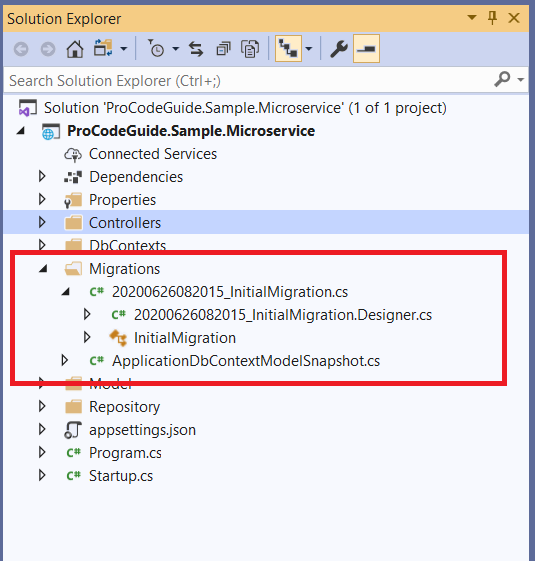

- #Ef add migration command how to#
- #Ef add migration command install#
- #Ef add migration command code#
- #Ef add migration command password#
- #Ef add migration command plus#
When you executed the previous Code First application, you may have noticed that a third table, _MigrationHistory, was created. With a few simple commands, the change will be propagated to the database to keep in sync with the application. We will now make a change to the "Employee" class to simulate this type of situation. They can change based on new business requirements and the database schema must change with Code First MigrationsĬlasses do not always stay static. Verify that it reflects the same data that was inserted by the application. Right-click Departments and Employees and select Retrieve Data. Notice that the HR.Employees and HR.Departments are created as defined by the class definitions.
#Ef add migration command password#
If prompted for a password, enter the password as hr and click OK.Įxpand Tables under the HR.ORCL connection. Note this step requires that you have installed and configured Oracle Developer Tools for Visual Studio. After completing the execution, expand the HR.ORCL connection in Server Explorer. Let's check whether these tables and data were added. Note that these table names are case-sensitive. This will create the "Employees" and "Departments" tables in the database and add one row to each of them. Replace the HR in the modelBuilder.HasDefaultSchema("HR") statement with the name of the schema you wish to use. If you do not wish to use the HR schema, then change the last line of the program. One property is commented it will be added in the last part of this tutorial. Next, we see how these two classes are defined by the.

It then creates an instance of the Employee and Department classes and adds data to them as seen in the screenshot below. The application first connects to an Oracle database using the OracleDbContext connection string that was configured in the App.config. The application needs Entity Framework 6 and ODP.NET assemblies and configuration from the NuGet steps.

We will be using that name shortly in the Code First application.Ĭopy the code snippet from the Programcs.txt file and paste it into the Program.cs of the Visual Studio project. Note the name of the connection string, OracleDbContext. Typically, the HR schema credentials are: User Id=hr and Password=hr. Modify the user id and password under the section to connect to the HR schema.
#Ef add migration command install#
Open the NuGet project that you created in the Using NuGet to Install and Configure Oracle Data Provider for. When the application is run, EF Code First will create database tables to represent these classesĪnd store a row each time the application saves data to a class instance. NET "Employee" and "Department" classes and save data using these classes. This OBE will connect to the Oracle database with the HR schema, though any schema can be used as long as there are no naming conflicts. To be able to do this, download and install Oracle Developer Tools for Visual Studio (12.1.0.2) or later from OTN. This tutorial uses Server Explorer to browse the Oracle schema to view Code First database changes.
#Ef add migration command plus#
The OBE will guide you in installing and configuring Entity Framework 6 and ODP.NET plus creating a new Visual StudioĬode First doesn't require Oracle Developer Tools for Visual Studio which provides integration with Server Explorer and Visual Studio designers. Using NuGet to Install and Configure Oracle Data Provider for. Install Oracle Database 11 g Release 2 or later.Įxtract these files into your working directory. Install Microsoft Visual Studio 2013 or later with. That property will then be added to the "Departments" table as a new columnīefore starting this tutorial, you should: You will then modify the class by adding a new property. When the application is run, these classes will be persisted as database tables with the data entered as rows. This tutorial will guide you in creating an EF application that creates "Employee" and "Department" classes, then adds data ODP.NET provides the data access to store the EF model inside Starting with Oracle Data Access Components (ODAC) 12c Release 3 (12.1.0.2.1), ODP.NET supports Code First andĬode First Migrations from Entity Framework 6. Model so that changes are accurately reflected in the persistent database store. Code First Migrations allows developers to evolve the code-based Which in turn can be persisted as database objects. It provides object-relational mapping for. Microsoft Entity Framework abstracts the relational, logical database schema and presents a conceptual schema to the. Lastly, you will modify those classes using Code First Migrations and propagate the changes so that they are reflected in the database tables. NET classes in Entity Framework, which will then create Oracle database tables and add data to those tables.
#Ef add migration command how to#
This tutorial demonstrates how to use Entity Framework (EF) Code First with Oracle Data Provider for.


 0 kommentar(er)
0 kommentar(er)
